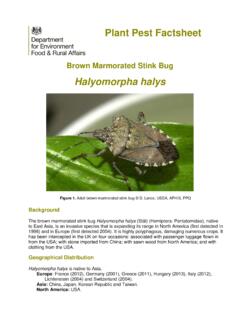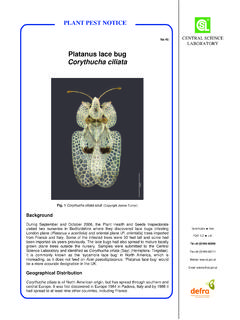Transcription of Updating the UK Rapid Pest Risk Analysis for …
1 Page 1 of 20 Updating the UK Rapid Pest Risk Analysis for xylella fastidiosa Defra Risk and Horizon Scanning Team 14th September 2017 Background PRAs are kept under review to ensure they are still fit for purpose taking into account new findings and scientific developments. xylella fastidiosa is no exception. Since Version 1 was produced in 2014 (Parkinson & Malumphy, 2014), there have been many new developments and the risks throughout Europe have been extensively assessed by EFSA (2015) in a 262 page scientific opinion. However, because the risks to the UK were considered not to have changed significantly, the focus has been on providing key information to the industry and the public with a Plant Pest Factsheet (Parkinson & Malumphy, 2015), a web-based resource (Forestry Commission, 2017), an information note on high risk hosts (Defra 2017) and guidance for importers (Defra & APHA, 2017) all accessed through the UK Plant Health Portal1.
2 This has been supported with webpages provided by the industry2 and the European Commission that provides a list of susceptible hosts in the EU (European Commission, 2015-2017). Two EU Horizon 2020 research projects (POnTE3, end date October 2019, and XF-ACTORS4, end date October 2020) are currently underway and their wide ranging X. fastidiosa objectives include a re-evaluation of the risks posed by this species throughout the EU. This document, provided as a new appendix to the UK PRA (Parkinson & Malumphy, 2014), has been written to determine whether the recent literature has substantially altered the risk ratings given in the PRA and their level of confidence. It provides a detailed evaluation of the evidence that the different X. fastidiosa subspecies and strains pose a risk to plant health in temperate climates such as those in the UK. 1 2 3 4 Page 2 of 20 Appendix 5 xylella fastidiosa : assessing the suitability of the UK climate 1.
3 Summary This appendix provides a more detailed assessment of the likelihood of X. fastidiosa establishment in the UK than that provided in the UK PRA (Parkinson & Malumphy, 2014). The literature has been reviewed and a detailed climatic comparison has been made between southern UK and the northernmost locations (in North America) and the southernmost locations (in South America) where the pathogen has been reported. This study confirms the risk ratings in the original PRA. xylella fastidiosa subsp. multiplex provides the greatest likelihood of establishment since none of the other subspecies have been found in temperate climates. The UK has much milder winters and cooler summers than those at the northernmost limits of its distribution in North America. Both the unlikely to moderately likely rating for establishment and the small rating for economic, environmental and social impacts in the UK PRA are still appropriate. However, there is considerable uncertainty since the pathogen has never been recorded from locations that have the mild winters and cool summers of the UK.
4 It is also important to note that X. fastidiosa is likely to be more widely distributed than current records suggest because it is difficult to identify on the basis of symptoms and to test for. 2. Introduction Based on a detailed review of the evidence and the significant areas of uncertainty, the UK PRA (Parkinson & Malumphy, 2014), concluded that X. fastidiosa was unlikely to moderately likely to establish and that its potential to cause economic, environmental and social impacts was small. These risk ratings were primarily based on climatic suitability because hosts and vectors are present. To assess the suitability of the UK climate for X. fastidiosa in more detail and confirm whether the previous risk ratings are appropriate, the following methods have been used: i. Compare climates at the limits of its distribution in the northern and southern hemispheres with those in southern UK using: climatic data from weather stations, gridded climatological data and climatic summaries based on the K ppen-Geiger classification, plant hardiness zones, degree day models and comparisons of monthly maximum and minimum temperatures.
5 Ii. Utilise models, such as MaxEnt and CLIMEX, to assess the potential UK distribution based on its current global distribution. iii. Utilise published information on its responses to climatic factors such as temperature to strengthen the results of climatic comparisons undertaken under (i) and (ii). All the methods have their limitations but the interpretation of the results is particularly challenging when, as for X. fastidiosa , the limits to a pest s distribution are poorly known and the species not only has a complex taxonomy but the responses to climate for each subspecies may vary. Reflecting this uncertainty, after reviewing all the evidence, EFSA Page 3 of 20 (2015) concluded that, although the potential for establishment in the EU was very likely with low uncertainty, at present it is difficult to anticipate precisely the possible distribution of X. fastidiosa in Europe owing to uncertainties linked to the optimal and minimal temperature requirement for growth of X.
6 fastidiosa subsp. multiplex found in Canada and northern USA and it has yet to be verified that the bacteria is able to shelter in roots and larger plants such as forest and ornamental trees (Hennenberger et al., 2004) . The EFSA PRA was published before the outbreaks of X. fastidiosa subsp. multiplex in Corsica, mainland France, the Balearics and mainland Spain but these findings do not change the conclusions. An additional purpose of this appendix to the UK PRA is to confirm whether the EPPO PRA conclusions are still appropriate for the UK based on an evaluation of any new information available or any new Analysis that has been conducted. 3. Compare climates at the limits of its distribution in the northern and southern hemispheres with those in southern UK The northernmost records in North America The complex taxonomy of X. fastidiosa was reviewed in section 6 of the UK PRA (Fera, 2014) and section of the EFSA PRA (EFSA, 2015).
7 Although the number of subspecies has now increased to six (Denanc et al., 2017), X. fastidiosa subsp. multiplex remains the subspecies posing the principal risk to the UK since it is found in temperate climates and has been recorded as far north as south-eastern Canada. It has principally been observed as causing bacterial leaf scorch in elm (Ulmus), sycamore (Acer) and oak (Quercus) but the pathogen has been found in many other trees and shrubs. However, strains isolated from elm are not pathogenic to sycamore, and vice versa (Gould & Lashomb, 2005) and X. fastidiosa subsp. multiplex itself has a complex taxonomy and the four clades have different host ranges (Nunney et al., 2013). The northernmost record from the Niagara Peninsula in southern Ontario, Canada, is of the strain affecting elms. It was found in leaves of Ulmus americanum with leaf scorching symptoms near a vineyard (Virgil), by a roadside in a small town (Niagara-on-the-Lake), and in a park (Fort Erie) by the Niagara River (Goodwin & Zhang, 1997).
8 There have been no subsequent records from this area and this may be due to the mortality caused by Dutch elm disease on the elm population. Elms infected with X. fastidiosa are very susceptible to Dutch elm disease (Gould and Lashomb, 2005). The greatest damage to elm by X. fastidiosa subsp. multiplex has been observed much further south in the mid-Atlantic United States, Washington, , where 30% of 3000 trees were affected in 2001 (Gould & Lashomb, 2005). The strain affecting oak has been studied extensively in New Jersey where it is found in every county (Zhang et al., 2011) and up to 35% of oaks planted as street trees and in landscapes are affected (Gould & Lashomb, 2005). Harris et al. (2014) showed that X. fastidiosa subsp. multiplex is responsible for significant crown dieback on Quercus palustris and Q. rubra in Washington DC. It is associated with oak decline as far south as Florida (Barnard et al., 1998) but no records could be found in the literature of the oak strain in states to the north of New Jersey.
9 The sycamore strain is also most common in street trees in the south-eastern and mid-Atlantic United States. Page 4 of 20 Elsewhere in Canada, there are records of X. fastidiosa from: Vancouver Island and the Gulf Islands, British Columbia on Acer macrophyllum (Callan, 1992). However, prior to 1997, when PCR-based diagnosis became available, records are considered unreliable because symptoms are easily confused with water stress, early senescence and other diseases, Dutch elm disease. Alberta on elm, though this is considered to be unreliable (Goodwin 1997). It was reported as Xylemella fastidiosum, an illegitimate name but this could also have been a major typing error (Jean-Fran ois Dubuc, personal communication, 28th June 2017). Saskatchewan on seven samples of elm (Ulmus) submitted to the Canadian Crop Protection Laboratory (Northover & Dokken-Bouchard, 2012). In the USA, there are records from: Washington State but this is incorrectly listed in EPPO PQR since Huang (2004) refers to Washington DC.
10 Oregon on blueberries (Vaccinium spp.) causing a leaf scorch disease (EPPO RS 2008/074). Illinois, Indiana, Kansas, Michigan, Missouri and Oklahoma based on a survey of leaves primarily from trees with symptoms sent in by foresters and other volunteers from North Central and Plains states (Adams et al., 2013). Precise locations and hosts are not given but a map of positives and negatives is provided from which the northernmost finding Michigan state can be approximately located to the town of Petersburg in the south east of the state. Alabama, Arizona, Arkansas, California, Delaware, District of Columbia, Florida, Georgia, Indiana, Kentucky, Louisiana, Maryland, Mississippi, Missouri, Montana, Nebraska, New Jersey, New Mexico, New York, North Carolina, Oklahoma, Pennsylvania, South Carolina, Tennessee, Texas, Virginia, West Virginia (EPPO PQR, 2014). Interpreting the northernmost records in North America It is not possible to determine the precise northernmost limit of X.





